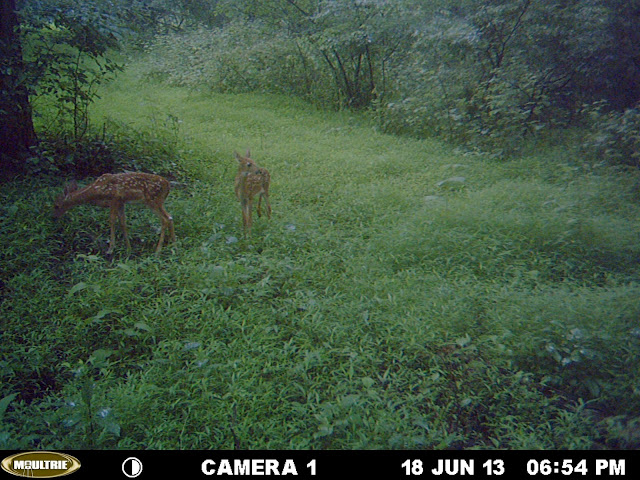Here's a list of Camera Trapping Fundamentals that I've been waiting to post for a while now. I've learned these lessons recently and hope that they can be useful to others.
1. Get Away From People- Most people that see the camera just wave to it or ignore it. Some choose to moon it, flick it off, or pee in front of it, and a select few will steal it. Minimize your chances of these incidents by going off trail, putting your camera 8 feet up (or higher) in a tree, or by monitoring lands for a week or so before you even put a camera up. Don't be naive to the fact that if you camera-trap for long enough, you will have at least one get stolen. It happens.
2. Get Away From Dogs- Dogs are naturally curious and will want to know exactly what your camera is doing on a tree. They will sniff your footprints out and go right up to your camera when they are not on a leash. If they sit at your camera for long enough, the dog owners may want to see what the dog is looking at, therefore leading another person figuring out where the camera is. Minimize dog encounters by placing camera traps away from trails, and across small streams from trails. Look for dog prints off-trail too. If you see dog prints, keep moving.
3. Find Dens- Animal dens and holes have harbored in some of my favorite and unexpected pictures of animals. Find dens by walking around the woods, following animals tracks, and using your nose. Dens reek of fresh kills, animal urine, and other scents. It is time consuming, you will get muddy, but the chance to photograph newly born animal young should be worth the time. All sorts of animals will come up to the den throughout the night as well, not just the animals that live in them.
 |
| Broke my own rules on this camera by using a dark colored strap that's easy to see. |
4. Don't Use Straps, Cables, Or Locks- These devices are usually dark colored or shiny and are made to secure your camera. They stick right out in the woods to even the most naive hikers, trappers, and hunters. I find it much better to take the time to hide the cameras rather than to just lock them up on a tree.
Natural shapes in the woods are not usually 90 degree angles, perfectly horizontal, or at all uniform. If you do choose to use straps, cables, or locks, you will get more people coming up to your cameras, but then they will be more secure. I've had cameras "perfectly placed" with these, only to have people take saws to trees, just to get the cameras off, so I rarely use locking cables anymore. If a person really wants the camera, they will take it no matter what kind of lock is on it.
5. Go Where The Animals Are- Deer trails and game trails are sure fire ways to see what's walking around. Follow them far and deep into the woods. Coyotes, bobcats, deer, and turkey all use deer trails. Water sources are also good, especially from July-September. Some great results that I have gotten have been on the banks of rivers and streams. Animals frequently use them as highways and so should you.
Find scat and tracks at trail intersections and on scent marked trees.
6. Know Your Camera- Test your camera for a few minutes during the day, and even for one whole night. Getting to know the trigger speed, flash, and depth of field are all key into figuring out how it will do when it is set up in the field. Know how long batteries will last and get at least a 4 gig SD card so you have some idea of when you should check your camera again, whether it be days or even months. Know how strong your LED or incandescent flash is for those night pictures. Some flashes are very strong and if you place the camera in the wrong place, all you will get is washed out pictures from the flash.
7. Don't Let The Sun Ruin Your Pictures- The sun rises in the east and sets in the west (at least in a general way). Do not point your camera in these directions or you will get a washed out or extremely bright picture of the sun during sunset or sunrise. Instead, point your camera north, south, or in a very shady location.
8. Work Quickly- When checking SD cards, setting the camera, or replacing batteries, don't rush, but move quickly. The less time spent at the site, the less of your scent will be spread. Try not to touch branches of trees and don't break sticks when you step on them. You are in the wild with wild animals, act like it. Don't leave any trash behind and get out fast.
9. Have A Checklist Ready When Checking Cams- It's important. Do it. On my checklist is changing batteries, making sure SD card is not full, make sure the SD card is set and in the camera, make sure camera is turned on, make sure nothing is obstructing the camera's lens, take a test picture, listen to the camera click to see if it is working, make sure nothing is left behind, and before leaving, make sure the camera is turned on again.
10. Know Who Owns the Land- Don't go on federal property to place a camera without permission. Know where you are and who holds the rights to the land you are on. While it is tempting to place a camera in National Parks to photograph that prize bobcat or bear that you saw while hiking, don't do it. There are steep fines and punishments for doing anything like this on government land. Don't be that guy in the woods that ruins "it" for everyone.










